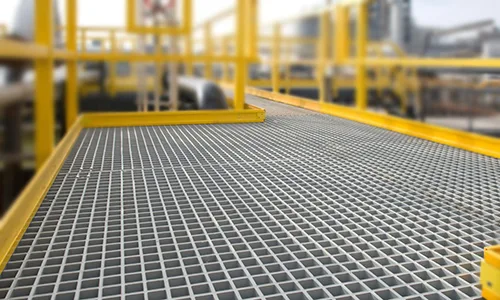Introduction
Industries ranging from wastewater management to agriculture continually seek materials that are durable, hygienic, and easy to maintain. Fiberglass grating for septic tanks and mushroom houses has emerged as a leading solution due to its impressive resistance to harsh environmental conditions, chemical exposure, and moisture. Unlike traditional materials such as steel and wood, fiberglass grating provides superior long-term value with minimal maintenance.
As an ISO-certified professional pultrusion manufacturer, Unicomposite specializes in creating high-quality fiberglass-reinforced plastic (FRP) products, including custom gratings. We extensive experience in various industries, including agriculture, aquaculture, and wastewater treatment, ensures tailored, high-performance solutions specifically engineered for challenging environments.

fiberglass grating for septic tanks and mushroom houses
Why Fiberglass Grating is Ideal for Septic Tanks and Mushroom Houses
Durability in Harsh Environments
Septic tanks and mushroom cultivation houses present uniquely demanding conditions, with high humidity, continuous moisture, and frequent exposure to chemicals and waste. Fiberglass gratings are inherently corrosion-resistant, significantly outperforming steel and wood, both of which rapidly deteriorate under such conditions.
According to industry data, FRP gratings can last up to 30 years without significant degradation, substantially reducing the lifecycle costs associated with replacement and repairs. An agricultural expert recently noted, “Switching to fiberglass grating resulted in an immediate reduction of maintenance effort by over 50% compared to our previous steel installations.”
Hygienic and Easy Maintenance
Maintaining hygienic conditions is crucial in both mushroom houses and septic systems to ensure product quality and operational safety. Fiberglass gratings feature non-porous, easy-to-clean surfaces, significantly reducing bacterial buildup and minimizing health risks.
One mushroom farm experienced substantial improvements after adopting fiberglass gratings, reporting a 40% reduction in sanitation-related labor hours annually. The smooth, easily washable surfaces of FRP gratings help streamline cleaning procedures and keep operating environments sanitary.
Key Considerations When Choosing Fiberglass Grating
Load-Bearing Capacity and Structural Integrity
Load-bearing capabilities are essential in applications such as septic tank walkways, platforms, or mushroom house shelving systems. The structural integrity of fiberglass gratings ensures safety and reliability under constant or heavy use.
When choosing fiberglass grating, evaluating the expected load and environmental stresses is crucial. Custom-engineered gratings from Unicomposite can be tailored to specific load-bearing requirements, ensuring long-term performance and safety for workers and operations alike.
Customization and Installation Flexibility
One significant advantage of fiberglass grating is its adaptability. Options include customizable sizes, thicknesses, surface textures (such as anti-slip coatings), and color coding for easy operational management. This flexibility allows businesses to precisely meet operational requirements while maintaining optimal safety standards.
To ensure a smooth installation, Unicomposite provides detailed guidelines and engineering support, ensuring that each grating system meets exact client specifications and operational needs. Proper installation directly influences the product’s longevity and efficiency, making expert consultation invaluable.
Real-World Applications and Benefits
Case Study: Agricultural Mushroom House
In one anonymized example, a large mushroom cultivation facility replaced wooden shelving with fiberglass gratings. Previously, the wooden structures required replacement every three to five years due to moisture-related deterioration. After switching to FRP grating, they observed an immediate reduction in replacement and maintenance costs. The gratings not only improved hygiene significantly but also reduced contamination risks, resulting in enhanced crop yields and profitability.
Case Study: Municipal Septic Tank System
In a municipal wastewater treatment plant, transitioning to fiberglass gratings dramatically improved operational reliability and safety. Traditional metal gratings suffered from corrosion, creating hazardous conditions and requiring frequent downtime for repairs. After installing fiberglass gratings, maintenance interventions dropped by 60%, substantially reducing downtime. Operators particularly praised the improved safety and structural stability, emphasizing increased peace of mind and reduced long-term costs.
Conclusion
Fiberglass grating offers unparalleled benefits for specialized applications such as septic tanks and mushroom houses, thanks to its robust durability, hygienic properties, and minimal maintenance requirements. Selecting the right grating solution can significantly enhance operational efficiency, safety, and long-term cost-effectiveness.
Unicomposite stands out as an industry-leading, experienced provider capable of delivering customized fiberglass grating solutions to meet diverse industrial requirements. Businesses interested in enhancing their operations are encouraged to contact Unicomposite for professional consultation or a tailored quote.
Frequently Asked Questions
1. How long does fiberglass grating typically last in septic tanks and mushroom houses?
Fiberglass gratings typically last up to 30 years in harsh conditions, significantly longer than traditional materials like steel or wood, which can degrade rapidly due to moisture and chemical exposure.
2. Can fiberglass grating handle heavy loads safely?
Yes, fiberglass gratings are engineered to meet specific load-bearing requirements, making them safe and reliable for heavy-duty applications such as septic tanks and agricultural facilities.
3. Is fiberglass grating easy to clean and sanitize?
Yes, fiberglass gratings feature a smooth, non-porous surface that resists bacterial growth and facilitates easy cleaning and sanitation, ideal for maintaining hygiene in mushroom houses and septic systems.
4. What customization options are available for fiberglass grating?
Fiberglass gratings can be customized in terms of size, thickness, surface texture, and color. This flexibility ensures they match precise operational needs and safety standards.
5. How difficult is the installation process?
Fiberglass grating installation is straightforward, especially when following manufacturer guidelines. Companies like Unicomposite provide detailed installation support, ensuring optimal product performance.




























